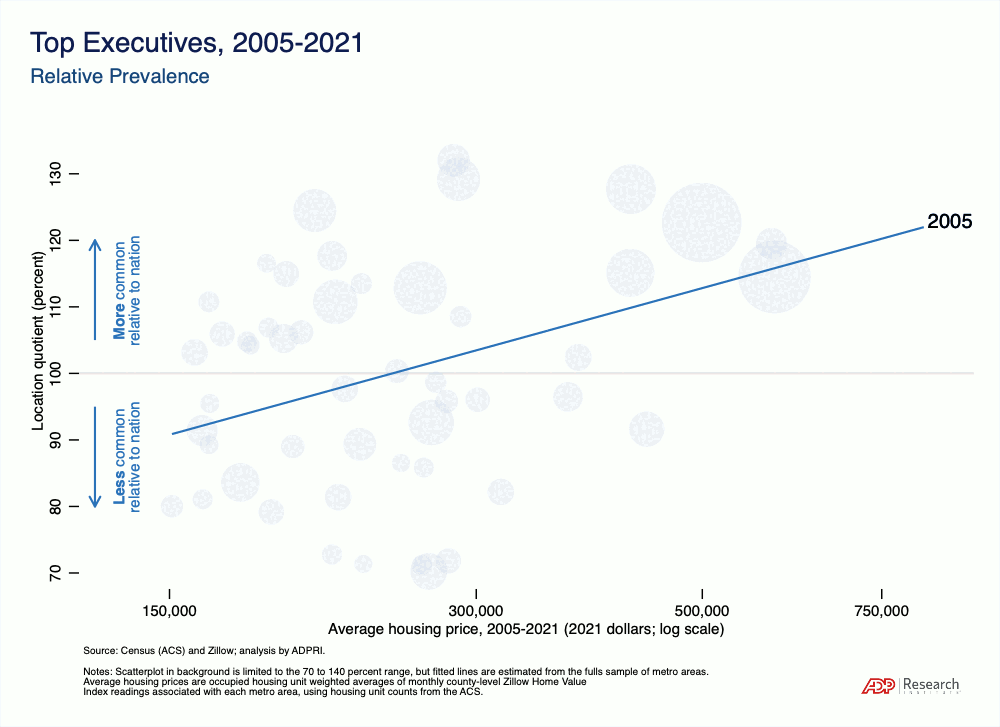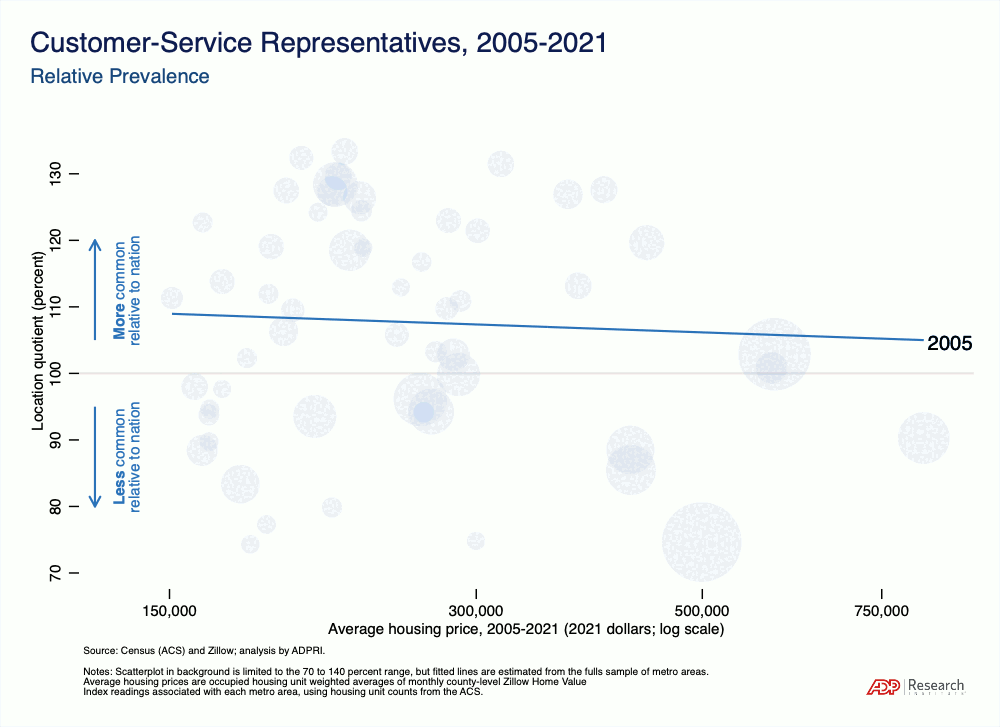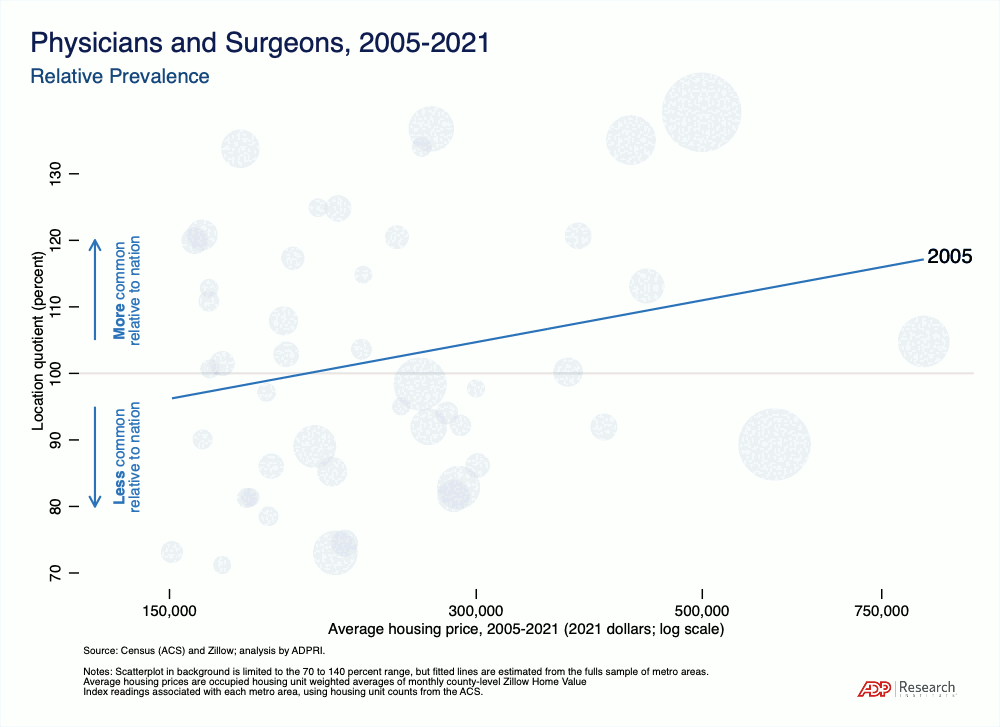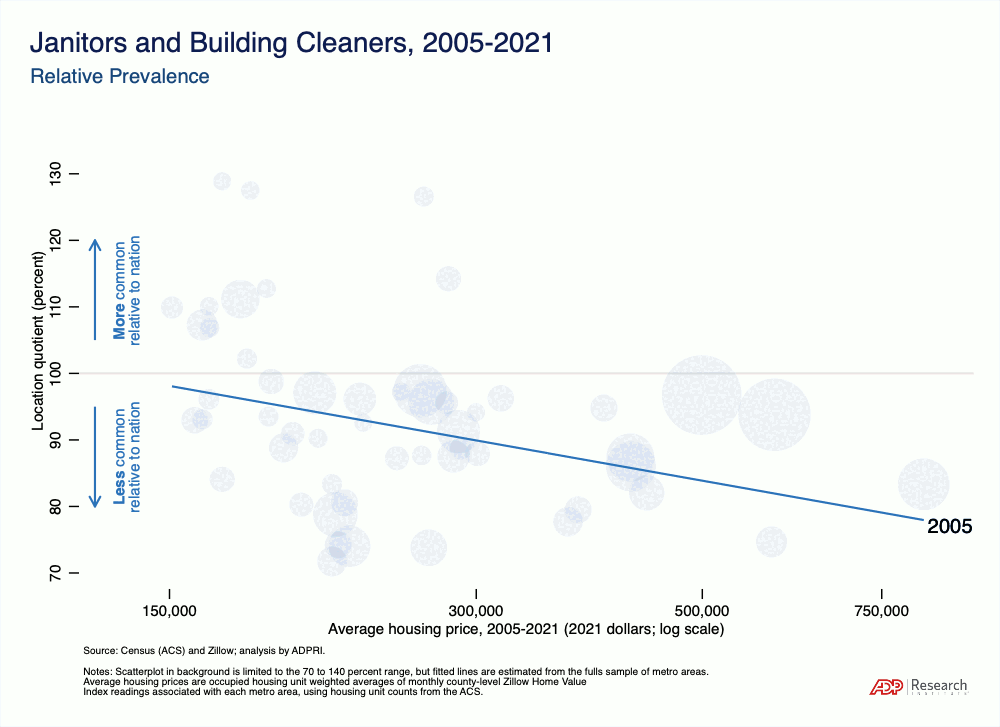Domestic offshoring: How housing costs are sorting work across U.S. cities
May 23, 2023
Economic and political power has historically been concentrated in a small number of command-and-control cities, which serve as nerve centers for business, ideas, and influence.
In recent decades, a growing regional divide between costly and affordable U.S. cities has been joined by technological innovations that make it easier for people in different places to collaborate. The combination is shifting low-paying work to more affordable places, leaving value-intensive jobs concentrated in expensive ones. The trend has been many years in the making and was likely further facilitated by the Covid-19 pandemic.
This process, which we call domestic offshoring, is leaving the nation’s command-and-control cities with a distilled workforce, one that’s heavily concentrated with executive decision-makers and other people who are highly paid, while lower-paid workers disperse. This growing economic and geographic divide threatens to limit opportunity for people in lower-cost regions and could have social and political consequences.
To illustrate domestic offshoring, the ADP Research Institute contrasted the whereabouts of top executives with those of customer-service representatives using location quotients, a tool used by economists and geographers to see if a job or industry is more or less common in a particular place compared to the national average1. We chose top executives because they are key decision-makers, and customer service representatives because they are the poster child of low-paid but geographically flexible work.
Top executives cluster in expensive cities; customer-service representatives in more affordable ones.
Figure 1A plots the location quotients of executives against typical housing prices for large U.S. metros as of 2021. The line’s upward slope is clear, reflecting the over-representation of top executives in expensive cities2. In the San Francisco Bay Area, for example, the location quotient for executives is approximately 140, indicating that these top-level decision makers are 40 percent more prevalent in that part of California than they are nationally. Figure 1B shows the same analysis for customer-service representatives. The downward-sloping trend indicates that these workers are underrepresented in expensive cities.
Domestic offshoring has intensified over time.
As shown in Figures 2A and 2B, cities whose housing prices appreciated the most also had the greatest increase in the prevalence of executives, and the greatest decline in the prevalence of customer-service representatives.
This finding helps substantiate the role of housing price appreciation in driving domestic offshoring. It’s not merely that executives are more prevalent in the nation’s most expensive cities, perhaps owing to their historical legacy as centers of commerce, but also that their prevalence has changed over time in line with the performance of housing markets3. For example, Austin, Denver, and Seattle had some of the sharpest increases in the prevalence of executives. Housing prices have risen sharply in these cities, but their economies historically haven’t rivaled those of Los Angeles, San Francisco, or New York.
Population growth, on the other hand, was uncorrelated with changes in the prevalence of top executives or customer-service representatives, further highlighting the role of housing affordability4.
The shift was underway well before the Covid-19 pandemic.
Figures 3A and 3B depict fitted lines similar to those in Figures 1A and 1B, but from the years 2005 to 2021. During this timeframe, the upward slope for top executives and downward slope for customer service representatives both grew steeper. That means the over-representation of top executives and the under-representation of customer-service representatives in expensive cities both became more pronounced, aligning with the gradual progression of domestic offshoring.


While the coronavirus pandemic normalized widespread remote work from home, the data show it wasn’t the main driving force behind domestic offshoring. Corporate decisions on where to site call centers, back offices, and other in-person work sites have long played a significant role.
The case of the doctor and the janitor
Not all types of work can be domestically offshored, of course. Tradable goods and services, such as products made in factories and shipped to buyers, are different from non-tradable ones such as haircuts, which must be provided wherever the consumer is. If production and consumption can’t be geographically separated, there should be no evidence of domestic offshoring.
To examine this premise, we considered another pair of occupations, medical doctors and janitors5,6. In contrast to the findings for top executives and customer-service representatives, the changes in location quotients for these two occupations weren’t correlated with housing price growth7.
The data show that physicians were more prevalent in the nation’s most expensive cities in 2005, and janitors less prevalent. Over time, however, the differences have evened out, which is inconsistent with them being subject to domestic offshoring.


Where does that leave us?
As technology improves, the scope of work that can be geographically shifted will only expand, and the process of domestic offshoring is likely to grow. But if high-paid and high-powered individuals continue to concentrate in command-and-control cities while others are priced out, regional inequality is likely to widen. Inasmuch as opportunities arise from geographic proximity, domestic offshoring may limit the scope of opportunity available to those living in more affordable parts of the country, while locking them out of the more expensive ones. And that, in turn, is bound to fuel social and political polarization.
Halting the technological progress that is expanding the boundaries of work that can be shifted geographically is neither sensible nor feasible. But undoing the policy constraints that stand in the way of curbing housing price appreciation in the nation’s most expensive places is both sensible and feasible. In other words, domestic offshoring is inherently a symptom of the regional divide in housing costs between the nation’s costly and affordable cities. Avoiding its worst implications requires housing policy to effectively address that divide.
Footnotes
1 An occupation’s location quotient is defined as the ratio of that occupation’s local share of employment and its national share of employment. Here, top executives and synonymous terms correspond to Standard Occupational Classification (SOC) codes beginning with 1110, which also include legislators. Customer service representatives and synonymous terms correspond to SOC occupation code 434051.
2 Underlying data are drawn from the American Community Survey via IPUMS USA (University of Minnesota, www.ipums.org). “Cities” in this analysis refers to Office of Management and Budget’s 2021 combined statistical areas (CSAs) or core-based statistical areas (CBSAs), using CSAs wherever they are available. CSAs are broader and thus prevent interpreting mobility within a large regional metro as domestic offshoring. “Average housing prices” are occupied housing unit weighted averages of county-level Zillow Home Value Index (ZHVI) readings, using occupied housing unit counts from the American Community Survey. ZHVI values are deflated using the consumer price index for all urban consumers (St. Louis FRED series CPIAUCSL).
3 This amounts to using first-differencing to eliminate non-time-varying unobserved error components. Of course, there is no guarantee that cities’ unobserved error components are entirely non-time-varying, or that the functional form of the data generating process is amenable to first-differencing.
4 A linear regression of the change in top executives’ metropolitan location quotients from 2005 to 2021 on those metros’ corresponding percent change in average housing prices yields a slope estimate of 0.215 (0.091), where robust standard errors are reported in parentheses. In contrast, substituting the percent change in population over that period in the right hand side yields a slope of -0.052 (0.272). For customer service representatives the corresponding slope estimates are -0.149 (0.058) with the percent change in housing prices on the right hand side and -0.065 (0.104) when substituting it with the percent change in population.
5 Some physician roles have begun being performed remotely through phone and video appointments and other technologies.
6 Physicians and surgeons refer to SOC codes 291060, 291210 and 291240. Janitors and building cleaners refer to SOC codes beginning with 37201.
7 Changes in physicians’ and janitors’ location quotients have also been uncorrelated with population growth. A linear regression of the change in physicians’ and surgeons’ metropolitan location quotients from 2005 to 2021 on those metros’ corresponding percent change in average housing prices yields a slope estimate of 0.027 (0.080), where robust standard errors are reported in parentheses. In contrast, substituting the percent change in population over that period in the right hand side yields a slope of 0.011 (0.212). For janitors and building cleaners the corresponding slope estimates are -0.009 (0.061) with the percent change in housing prices on the right hand side and -0.084 (0.126) when substituting it with the percent change in population.




